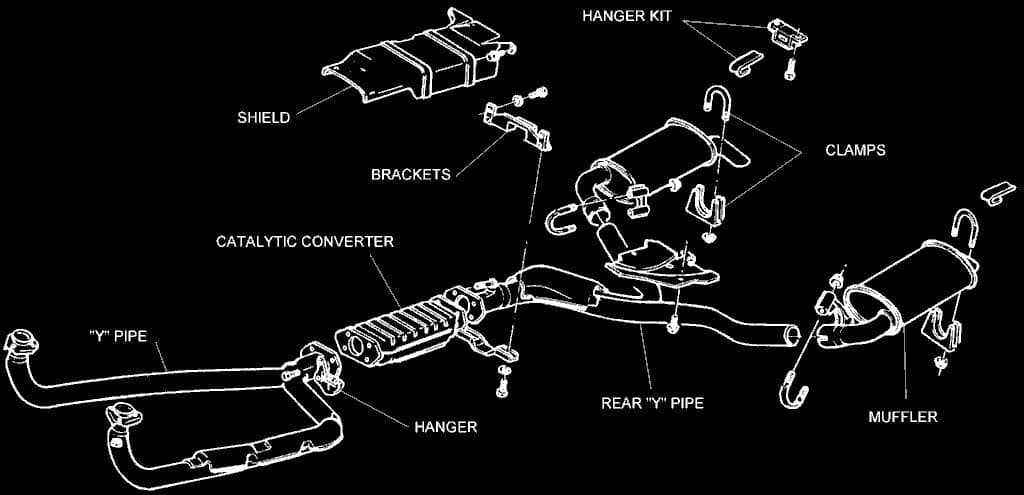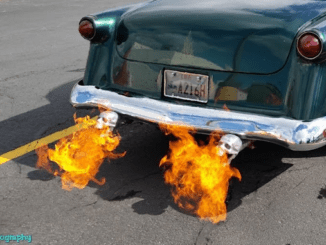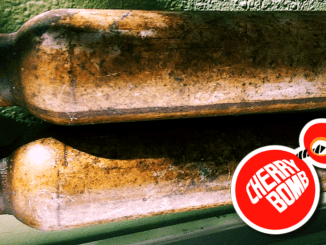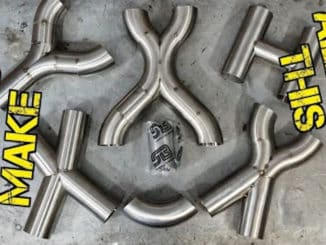
Exhaust systems are a series of pipes that evacuate the spent gases from an engine. So basically, the exhaust system will just vent waste gases from the engine.
It all depends on the overall system design, but the exhaust gas can flow through either:
- a turbocharger that will increase the engine power
- a catalytic converter that will reduce the air pollution
- a muffler that reduces the noise.

In most production engines, the manifold is made of cast iron. It is designed to use the least amount of metal, to make sure it is lightweight and to occupy the smallest amount of space necessary to collect the gas from the multiple cylinders and combine those flows into one single pipe.
Often the size restriction results in a design that does not do the best job of venting the gases.
Headers
A header is another name for a manifold, more specifically, the term “header” refers to a manifold in which the engineering focus has shifted from weight and size to concentrating on the optimal flow of the exhaust gases.
In a set of high-end headers, the pipe lengths are optimized to enhance flow in a particular engine rpm (revolution per minute) range.
Mufflers
Mufflers are a portion of the exhaust system which decrease (or “muffle”) the volume of the exhaust. Aside from affecting the sound produced, mufflers do not serve any primary function.
Mufflers are often lined with fiberglass insulation and/or resonating chambers (where sound waves are interrupted in a way that cancels them out).
Mufflers are the cheapest way to make your ride sound more aggressive, although some cutting and welding is required to replace your stock muffler.
Axle-Back Exhaust
An axle-back is a part of the exhaust system that contains a muffler, as well as the pipes needed to install the muffler.
An axle-back is the easiest way to get some growl out of your ride as it replaces your muffler without the need to cut, weld or otherwise modify your existing exhaust system, they just bolt right up!
Cat-Back Exhaust
A cat-back is the portion of the exhaust system that goes from the outlet of the catalytic converter to the final vent to open air. This then will normally include the pipe from the converter to the muffler. The muffler is then the final length of pipe to open air.
Cat backs are quite a popular performance enhancement. They usually use a larger diameter pipe than what they would on the stock system. The good systems will have mandrel bent turns. This allows the exhaust gas to leave with as little back pressure as possible.
Header-Back Exhaust
The header back is the portion of the exhaust system from the outlet of the header all the way back. Header-back exhausts are more common for turbocharged cars and can also be referred to as “turbo-back”. Specifically, a turbo-back is the portion of the exhaust system that goes from the outlet of a turbocharger and back.
Header-back exhaust systems vary in that some come with a replacement catalytic converter (typically a high-flow aftermarket cat), a “resonator”, which is like a muffler without insulation or baffling, or a “test-pipe”, which is a small piece of pipe that replaces the cat and further increases flow. Installing a resonator or test-pipe in place of the cat is commonly referred to as a “cat-delete”.
Full Exhaust Systems
Full Exhaust Systems, as the name implies, replace your entire exhaust system from the exhaust ports back. The components of a full exhaust system are typically designed and tuned to work well together and optimize gas flow and back pressure to increase performance.
Exhaust Tips
The final bit of the exhaust, which is the bit that is visible where it vents to open air. The exhaust pipe must carry any toxic or noxious gases away from the vehicle. It often just ends with a straight or angled cut. Sometimes it may include some kind of a fancy tip.
The tip will then often be chromed and is often a larger diameter than the rest of the exhaust. This will then produce the final reduction in pressure, which will also prevent the edges from rusting and can be used to make the appearance of the vehicle look better.




